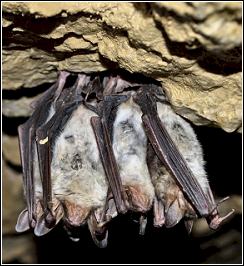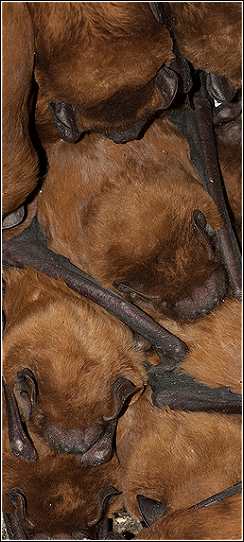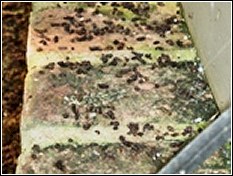
on brick around house
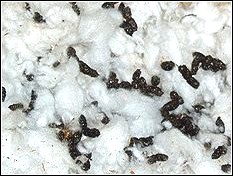
on attic insulation
According to the C.D.C. (Center for Disease Control) bats are natural reservoirs, or vectors of several zoonotic infections. These include: Severe Acute Respiratory Syndrome (SARS), Henipavirus, Nipah, and Hendra. Bat droppings, also known as guano, can play a part in transmitting certain diseases such as Hystoplasmosis from bats to humans. And bats can carry rabies. This is one of the reasons you never want bats in the house.
It's true, bats can carry and transmit disease, you can get Hystoplasmosis from Guano, about 1% of bats carry rabies and some may even carry lice.
However, looking at the big picture, these odds are small and bats are more beneficial than harmful - as long as they're not in buildings.
Regarding Guano, Hystoplasmosis can be a scare with bats at times - but in a building, as opposed to a cave, it is not typically a concern.
This is because the right conditions must be present to produce the fungus. For instance, Guano generally needs to come into contact with the ground and exist in a dark and humid or damp environment before it becomes a suitable host for the hystoplasmosis fungus to grow.
Since caves provide a perfect atmosphere for hystoplasmosis to thrive, the disease is often referred to as "cave disease" or "spelunker's lung".
So, if you lived in a damp cave or in the wet, humid sewer systems of a large city, we would be more concerned, but not as concerned when talking about the hot dry attic or ceiling of a building.
To illustrate the risk, you can see from the following sequence what would need to occur and how it "might" lead to contracting Hystoplasmosis:
As you can see from the above sequence, concerns regarding guano and hystoplasmosis are typically overstated and unfounded.
If you have found a few pieces of guano, or even a five inch pile, on top of your outdoor coffee table, you have likely gone online to learn more.


And, if you look hard enough on the internet, you will find plenty of info about bat guano causing respiratory disorders that will kill you.
If you want to be terrified, you will likely need to go to another website.
Our mission is not to scare you into using our services, but rather it is to educate and inform you - so you can make smart, accurate decisions.
Even though Hystoplasmosis is not a likely threat under most conditions you would find inside your home, it is still possible to become infected, and it is still a serious respiratory disorder that can kill you. It is important to know the facts so you can take the proper safety precautions.
Just because a home, church or place of business isn't a cave, doesn't mean that it can't be affected by bat guano related histoplasmosis.
If you describe a smell in your building similar to the smell of a ripe cat litter box or ammonia, we would be concerned, and so should you.
Most of the time, if guano presents any sort of health risk, it is typically in an older building and is usually in a church, fire department, or commercial property. However, newer homes are not immune, one of the worst homes we ever saw or smelled was only a mere 9 years old.
This does not mean that we have not walked into homes without cats that smelled like a litter box just the same, and strongly suggested removing all of the insulation, and treated it like a hazardous material situation; but this is uncommon. Out of hundreds of homes in the past decade that we have searched to find bats, we have encountered only 3 homes that needed to have insulation removed and just 13 businesses, yet to date.
Evict the bats and clean up as much guano as possible is the mission.
The fact of the matter is, a little bit of guano on the ground or in your attic is not going to hurt you, and it certainly won't kill you in most circumstances. If a wildlife control professional insists that you remove all of your attic insulation because of just a little bit of guano being sprinkled on top of it, a red flag should be raised in your mind and we suggest you get a second opinion, as well as question their professionalism.
However, if you have a house that smells like a nasty cat litter box, and you have no cats, and you know that you have bats, you could indeed have a guano problem on your hands. This because under normal, dry conditions, bat guano doesn't really smell. The droppings would likely have to accumulate in mass amounts and become saturated with bat urine to create such a strong smell.
So, by the time it has accumulated enough to create a strong odor, you could indeed have a potential health hazard in place.
This is another good reason to let a professional do the job, a qualified company should have the proper equipment to go in and safely clean up the mess properly with the potential safety and health risks in check.
Bat jobs complicated by serious guano issues can generate a price tag from $3,000 to $53,000 - and those are typical, legitimate charges. So you will want to find a wildlife control company that will do the job right.
We can assist you with your insurance claim, but strongly suggest that you do not call your insurance company until we do an inspection.
This is because insurance companies will not pay for bat exclusion and prevention, they will only pay for damage. Bats do not always cause a massive amount of damage, but often times mandate an incredible amount of prevention work to get rid of them and keep them out for good.
The process of getting the house fixed to get rid of bats is called bat eviction. The process of making it so that once the bats fly out that they cannot re-enter, is called a bat exclusion.
Exclusion for one bat or 1,000 bats is the same amount of work because the home modifications are not dependent on the size of the bat colony, they are dependent on the construction and number of entrances and exits.
Proper exclusion repairs are important because a bat eviction is totally worthless if all the evicted bats have to do to get back in is fly into your attic or chimney from an alternate source on the other side of the building.
As expensive as bat jobs can be, if your house does not smell like a cat litter box due to bat guano and urine, we will typically encourage you to not spend thousands of dollars to remove and sanitize all of the insulation.
Instead, we prefer to treat your pocket book as though it was our own and will encourage you to have us address any light smells with an un-scented, natural and non toxic product which will encapsulate and begin to destroy any organic matter.
Guano can actually be beneficial in some cases, and its uses can even be found in some surprising places.
For instance, did you know that bat guano is a very common ingredient in women's mascara. Of course, unlike the guano you may find on the ground outside your home, it has been sterilized and sanitized.
Throughout history bat guano has been used as a source of saltpetre (potassium nitrate) for the production of gun powder.
During the Civil War, soldiers often depended on the guano found in bat caves to make gun powder on demand when assistance and supply lines were cut off by opposing forces.
And, bat guano is rich in beneficial concentrations of nitrogen, phosphorus and potassium. Consequently, it has been used successfully for hundreds of years as an organic fertilizer. It contains microbes which are beneficial to plants and soil. And, guano based fertilizers also have fungicidal properties that help protect growing plants from harmful fungi.
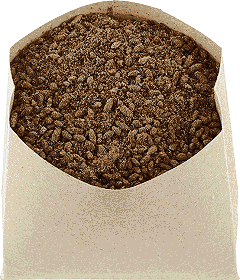
In addition to the possibility of getting hystoplasmosis from guano or a disease from direct contact with bats, there is another health and safety concern to consider as well. Like many kinds of wildlife, bats can also bring bugs and parasites with them when they invade your home.
One of these parasites is known as a "bat bug". These are a close relative to the better known bed bug and are similar in looks and the problems they cause too. They are such a close relative that you could describe the difference between them as microscopic. Some pest control companies can't even tell the difference between the two.
Like bed bugs they can invade your home, be quite bothersome and carry with them the same undesirable outcomes that bed bugs can bring.
"Bat Ticks" are a soft backed parasite that lives off the blood of bats.
When bats leave the roost these ticks will likely invade a nearby room or structure in search of another warm blooded host, such as another animal or a human. They look a bit different from other ticks and individuals who find them often don't know what they are.
These ticks can live a long time without feeding and like their counterparts can transmit disease when they bite.
Bats can be reservoirs for more than 60 viruses that can infect humans, including the rabies and Ebola viruses.
But not all bat transmitted diseases are deadly of course, for instance, the coronavirus is similar to the common cold. Viruses that can jump from animal to human are known as "zoonotic" viruses.
Compared to other animals, bats tend to carry more pathogens harmful to humans. Bats cluster together tightly in great numbers, so diseases have an opportunity to spread from host to host easier than they might with some other species. Bats also appear to have developed sophisticated defense systems that might help them survive various infections that would otherwise make a human host very ill or even die.
It is important to note that some diseases associated with bats are not necessarily a threat within the United States at this time. For instance, Marburg hemorrhagic fever is found exclusively in Africa, so you are not going to catch it from an encounter with a bat in Florida.
For the most part, you should not let what you read about bats on the internet scare you, but because they can carry and transmit diseases, exposure to guano and any interaction with bats should always be taken seriously, and proper safety steps should always followed.
